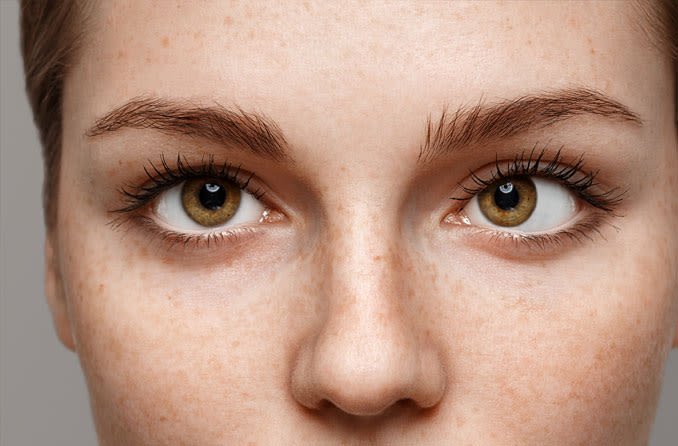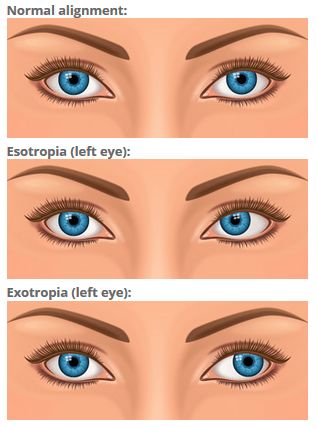How to Know if You Have Strabismus
Strabismus (crossed eyes)
- Strabismus types
- Symptoms and signs
- What causes strabismus?

Strabismus is a failure of the ii eyes to maintain proper alignment and work together every bit a team.
Strabismus can be constant or intermittent. The misalignment might e'er affect the aforementioned eye (unilateral strabismus), or the 2 eyes may take turns existence misaligned (alternating strabismus).
To prevent double vision from congenital and early childhood strabismus, the encephalon ignores the visual input from the misaligned heart, which typically leads to amblyopia or "lazy middle" in that center.
Co-ordinate to the American Association for Pediatric Ophthalmology and Strabismus, approximately 4% of the U.S. population has crossed optics or some other type of strabismus.
Strabismus types
Large-angle strabismus
When the misalignment of the eyes is large and obvious, information technology is called "large-angle" strabismus, referring to the angle of departure between the line of sight of the straight eye and that of the misaligned eye.
Typically, abiding large-bending strabismus does not cause symptoms such every bit heart strain and headaches because there is near no attempt by the brain to straighten the eyes. Considering of this, large-angle strabismus usually causes astringent amblyopia in the turned eye if left untreated.
Small-bending strabismus
Less obvious centre turns are called "small-angle" strabismus.
Less noticeable cases of small-angle strabismus are more than probable to cause confusing visual symptoms, especially if the strabismus is intermittent or alternating. In improver to headaches and eye strain, symptoms may include an inability to read comfortably, fatigue when reading, and unstable or "jittery" vision. If small-angle strabismus is constant and unilateral, it tin lead to significant amblyopia in the misaligned eye.
Both large-angle and pocket-sized-bending strabismus tin be psychologically damaging and bear upon the self-esteem of children and adults with the condition, equally it interferes with normal eye contact with others, often causing embarrassment and clumsiness.
Symptoms and signs
The primary sign of strabismus is a visible misalignment of the eyes, with one eye turning in, out, up, down or at an oblique bending. If you have strabismus, one heart looks directly at the object y'all are viewing, while the other eye is misaligned inward (esotropia, "crossed eyes" or "cross-eyed"), outward (exotropia or "wall-eyed"), upwardly (hypertropia) or downwardly (hypotropia).
Corneal lite reflex (Hirschberg) test: A screening test for strabismus that evaluates eye alignment based on the location of reflections of light shined at the eyes.
Newborns often accept intermittent crossed eyes due to incomplete vision evolution, but this frequently disappears as the babe grows and the visual system continues to mature. Most types of strabismus, even so, do non disappear equally a kid grows.
Routine children'southward eye exams are the best mode to discover strabismus. More often than not, the earlier strabismus is detected and treated following a kid's eye test, the more successful the outcome. Without treatment, your child may develop double vision, amblyopia or visual symptoms that could interfere with reading and classroom learning.
Encounter RELATED: Corneal low-cal reflex (Hirschberg) test
What causes strabismus?
Each eye has six external muscles (called the extraocular muscles) that control middle position and motility. For normal binocular vision, the position, neurological control and functioning of these muscles for both eyes must be coordinated perfectly.
Strabismus occurs when there are neurological or anatomical problems that interfere with the command and function of the extraocular muscles. The problem may originate in the muscles themselves, or in the nerves or vision centers in the encephalon that command binocular vision.
Genetics also may play a function: If you or your spouse has strabismus, your children have a greater risk of developing strabismus as well.
Strabismus caused by accommodative esotropia
Occasionally, when a farsighted child tries to focus to compensate for uncorrected farsightedness, he or she volition develop a type of strabismus chosen accommodative esotropia, where the eyes cross due to excessive focusing endeavor.
This status ordinarily appears earlier ii years of age merely can also occur later in childhood. Often, accommodative esotropia can be fully corrected with eyeglasses or contact lenses.
Strabismus surgery
In most cases, the only effective treatment for a constant centre turn is strabismus surgery. If your general middle doctor finds that your child has strabismus, they can refer you lot to a pediatric ophthalmologist who specializes in strabismus surgery.
The success of strabismus surgery depends on many factors, including the direction and magnitude of the eye turn. In some cases, more than one surgery may be required. The strabismus surgeon can give yous more data almost this during a pre-surgical consultation.
Strabismus surgery can too finer marshal the eyes of adults with long-standing strabismus. In many cases of adult strabismus, still, a significant degree of amblyopia may remain even after the affected eye is properly aligned. This is why early treatment of strabismus is so important.
The earlier strabismus is treated surgically, the more likely it is that the affected middle will develop normal visual acuity, and the two eyes will function together properly equally a squad.
Non-surgical strabismus treatment
In some cases of intermittent and small-angle strabismus, information technology may exist possible to improve middle alignment non-surgically with vision therapy.
Esotropia (crossed eyes) needs to be treated early on in life to preclude amblyopia.
For case, convergence insufficiency (CI) is a specific blazon of intermittent exotropia in which the eyes usually align properly when viewing a distant object, but fail to achieve or maintain proper alignment when looking at a shut object, such equally when reading, resulting in one eye drifting outward. Convergence insufficiency tin can interfere with comfortable reading, causing center strain, blurred vision, double vision and headaches.
There is also some bear witness that suggests CI can cause attention bug and bear on bookish operation in children. A study conducted by Mayo Clinic researchers found that children with exotropia (including convergence insufficiency) at an early historic period were significantly more than likely to develop attention deficit hyperactivity disorder (ADHD), adjustment disorder and learning disabilities by early adulthood.
Certain types of strabismus take also been associated with an increased take chances of myopia.
On the brilliant side, it appears non-surgical vision therapy can be an effective treatment for convergence insufficiency. In a study published in Archives of Ophthalmology, 73% of 221 children with symptomatic convergence insufficiency had a successful or improved outcome post-obit a 12-week plan of office-based vision therapy combined with heart exercises performed at home.
Sometimes, a strabismus surgeon may recommend a program of vision therapy for a period of fourth dimension after strabismus surgery to treat amblyopia and pocket-sized binocular vision issues that might remain after surgery.
In these cases, the term "orthoptics" (ortho = directly; optics = eyes) rather than "vision therapy" might be used to describe this treatment, which may exist provided by an orthoptist working closely with the surgeon rather than by an optometrist.
Inquire your eye dr.
When consulting with your eye medico or strabismus surgeon prior to treatment, here are a few of import questions to ask:
-
If surgery is recommended, enquire whether ane surgery will suffice or if boosted procedures are likely to be necessary.
-
Ask the middle surgeon about the success rates for the type of strabismus and the surgery they are recommending.
-
Inquire what criteria are used to make up one's mind if the handling is a success. In other words, is "success" defined every bit reducing the eye turn so the optics are better aligned and look more natural in appearance, or is success defined as optics that are perfectly aligned with normal visual acuity, eye teaming and depth perception.
-
For optometrists or orthoptists, ask about the success charge per unit, likely duration and costs of vision therapy (or orthoptics).
-
Inquire what portion of the costs of surgical or non-surgical treatments for strabismus are covered by health insurance or vision insurance.
Remember, children exercise not "outgrow" strabismus. For all-time visual outcomes and to prevent developmental delays and other problems, seek handling for strabismus as soon equally possible.
Judith Lee and Gretchyn Bailey also contributed to this commodity.
READ Adjacent: Most common childhood center diseases
Page published in March 2019
Page updated in February 2022
Source: https://www.allaboutvision.com/conditions/strabismus.htm
ارسال یک نظر for "How to Know if You Have Strabismus"